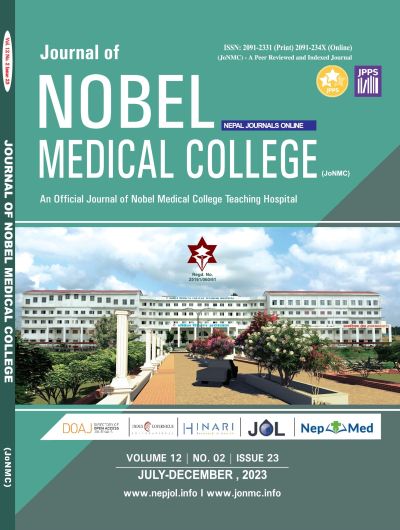Laser Hemorrhoidoplasty for Treatment of the Hemorrhoids in Eastern Nepal
DOI:
https://doi.org/10.3126/jonmc.v12i2.61093Keywords:
Hemorrhoids, Hemorrhoidectomy, Laser, Rectal diseaseAbstract
Background: Millions worldwide are affected by hemorrhoids (prevalence 2.9%-27.9%), causing symptoms in over 4% of individuals. These anorectal disorders result from enlarged anal hemorrhoidal cushions, often due to constipation. Internal or external, they're graded by prolapse severity, with common symptoms including painless rectal bleeding. Treatment options range from conservative to surgical, with the gold standard, Milligan-Morgan hemorrhoidectomy, associated with postoperative pain. Laser hemorrhoidoplasty, a minimally invasive diode laser approach, shows promise, offering less postoperative pain, shorter hospital stays, and fewer complications than traditional surgical methods.
Materials and Methods: A prospective observational study of 40 adults undergoing laser hemorrhoidectomy for symptomatic Goligher’s grade II and III hemorrhoids at Nobel Medical College Teaching Hospital, Biratnagar, Nepal, from June 2022 to June 2023. Outcomes included pain scores, bleeding, operative time, postoperative complications, hospital stay length, return-to-work time, and patient satisfaction measured by QOL SF36 scoring.
Results: Among 40 patients, 16 were male and 24 females, averaging 42.32 ± 12.26 years. Grade III hemorrhoids were found in 31 patients, Grade II in 9. Operative time averaged 17.22 ± 2.14 minutes, with one case of managed intraoperative bleeding. Postoperative symptoms included pain, skin tags, and wound infection, but no reactive bleeding, urinary, or stool/flatus incontinence. Two cases experienced recurrence. Patient satisfaction in general health evaluation scored 65.11 ± 10.35.
Conclusion: Laser hemorrhoidoplasty is associated with less complications, quicker operative time, quick recovery and similar patient satisfaction when compared to surgical methods of hemorrhoidectomy.
Downloads
Downloads
Published
How to Cite
Issue
Section
License
Copyright (c) 2023 Amit Bhattarai, Dinesh Adhikari, Saurav Poudel, Anil Kumar Mehta, Dipak Kumar Yadav, Bivusha Parajuli, Abhilekh Kumar Singh

This work is licensed under a Creative Commons Attribution 4.0 International License.
JoNMC applies the Creative Commons Attribution (CC BY) license to works we publish. Under this license, authors retain ownership of the copyright for their content, but they allow anyone to download, reuse, reprint, modify, distribute and/or copy the content as long as the original authors and source are cited.




